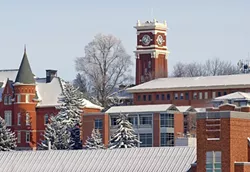$2 billion is a lot of money.
That's the amount that the Washington state Office of Financial Management estimated Initiative 1351, fully implemented, would have cost the state every year.
If it was implemented, it would have bumped class sizes down to 17 in grades K-3, 24 in grade 4, and 25 in the rest of the grades. And for schools with more than half of their kids on free or reduced lunch, it would have gone even lower: Fifteen students per class in K-3, 22 students in grade 4, and 23 students in the older grades. (Schools without the space to decrease class sizes would have been able to use the money for other instructional costs.)
When I took a look at the research on the issue last year, I found it showed that lower class sizes did help students, especially at the early grades, and especially low-income students. But I also found a study showing that the flood of inexperienced teachers, necessary to meet the class-size reductions, wiped out most of the gains. Many of the studies came to the conclusion that, while lower class sizes can help students, it's a very expensive way to do it.
The $2 billion per year cost is on top of the K-3 class size reductions already being implemented because of the McLeary court decision. Instead, the legislature agreed today to delay the initiative for at least four years. A lot of the narrowly passed initiative's supporters are angry about this, accusing the legislature of defying the voters' will.
But since the initiative didn't specify exactly how to fund the initiative, it's easy to miss how titanic that number is (for example, it's 10 times the budget of Titanic.)
I talked with Paula Moore, senior budget analyst for education in Office of Financial Management, who confirmed something I'd heard discussed by legislators: For the cost of I-1351, you could roughly make every public university and community college in the state tuition-free for Washington resident undergrads.
"We have a very rough, back-of-the-envelope estimate," Moore says. It looks at what students are paying for tuition now, and subtracts the amount of state financial aid (which wouldn't be necessary if tuition was eliminated.) It assumes no budget cuts or cost increases or changes in the number of people who enroll. Students would still have to pay for fees and textbooks.
Still, here's a thought experiment: Ask voters if they'd rather have the class-size gains laid out by 1351, or no tuition at any public Washington state college. Which would they choose?
Heck, our neighbor to the south just announced they'd make community colleges tuition-free to all graduating high school students.
I ran the notion past state Sen. Michael Baumgartner, who's championed more higher education spending, and successfully pushed for a rare tuition decrease in this year's budget.
"You can do a lot with $2 billion," Baumgartner says. Part of that is how massive the basic education budget is compared to higher education. Just this year's increase in K-12 spending, he says, is larger than the entire higher education budget.
"The fight to make tuition affordable and accessible is going to be ongoing," he says. "What is the price level where a student can work through a part-time job and get through school without debt?" That's his goal. Next year, for example, he wants to take a run at fixing textbook costs.
Here are some other rough calculations, not taking into account secondary costs and consequences, of what $2 billion could buy Washington state education:
That's $1894.80 for every public school student in the state, every single year. Every school year, you could give every student, even the kindergartners, a brand new laptop and a brand new tablet for that price.
That's enough for a $33,897.15 raise to every classroom teacher in Washington, bringing the average teacher salary to over $86,130.0, the highest in the country by more than $10,000.
That's enough to pay every unemployed person in the state, $10,471 on top of any current aid or benefits.
That's enough for a $283.20 bookstore gift certificate, every year, for each man, woman and child in Washington state .
That's $1 million for each of the approximately 2,000 biology students who failed to pass the state's biology test or the state's alternative. The Senate Democrats struck a deal to allow them to graduate anyway. Bill Nye the Science Guy gave a commencement speech at Rutgers for $35,000 this year. Assuming no finite limitation on Bill Nye's time, and that he would work at the same rate, each student not passing the biology test could get a personalized lecture from Bill Nye about the importance of biology 28 and a half times a year.
Or, you could get $1 million worth of one-on-one tutoring for each of those students.
Feel free to make your own suggests for how the state should spend $2 billion, if it had it. Lower class sizes? Eliminate tuition? Splashdown season-passes for everyone?

